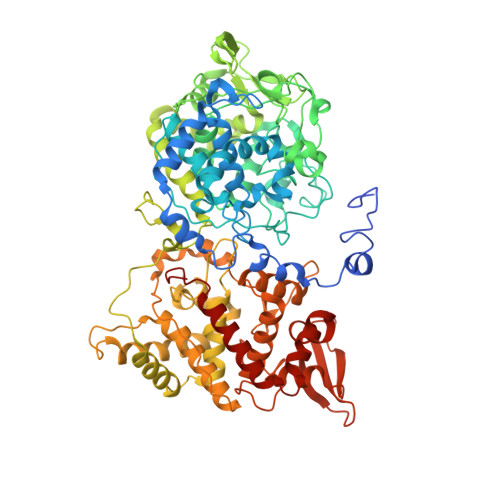Eukaryotic Catalase-Peroxidase: The Role of the Trp-Tyr-Met Adduct in Protein Stability, Substrate Accessibility, and Catalysis of Hydrogen Peroxide Dismutation.
Gasselhuber, B., Carpena, X., Graf, M.M., Pirker, K.F., Nicolussi, A., Sundermann, A., Hofbauer, S., Zamocky, M., Furtmuller, P.G., Jakopitsch, C., Oostenbrink, C., Fita, I., Obinger, C.(2015) Biochemistry 54: 5425-5438
- PubMed: 26290940
- DOI: https://doi.org/10.1021/acs.biochem.5b00831
- Primary Citation of Related Structures:
5CJH - PubMed Abstract:
Recently, it was demonstrated that bifunctional catalase-peroxidases (KatGs) are found not only in archaea and bacteria but also in lower eukaryotes. Structural studies and preliminary biochemical data of the secreted KatG from the rice pathogen Magnaporthe grisea (MagKatG2) suggested both similar and novel features when compared to those of the prokaryotic counterparts studied so far. In this work, we demonstrate the role of the autocatalytically formed redox-active Trp140-Tyr273-Met299 adduct of MagKatG2 in (i) the maintenance of the active site architecture, (ii) the catalysis of hydrogen peroxide dismutation, and (iii) the protein stability by comparing wild-type MagKatG2 with the single mutants Trp140Phe, Tyr273Phe, and Met299Ala. The impact of disruption of the covalent bonds between the adduct residues on the spectral signatures and heme cavity architecture was small. By contrast, loss of its integrity converts bifunctional MagKatG2 to a monofunctional peroxidase of significantly reduced thermal stability. It increases the accessibility of ligands due to the increased flexibility of the KatG-typical large loop 1 (LL1), which contributes to the substrate access channel and anchors at the adduct Tyr. We discuss these data with respect to those known from prokaryotic KatGs and in addition present a high-resolution structure of an oxoiron compound of MagKatG2.
- Department of Chemistry, Division of Biochemistry, BOKU-University of Natural Resources and Life Sciences , Muthgasse 18, A-1190 Vienna, Austria.
Organizational Affiliation:


















